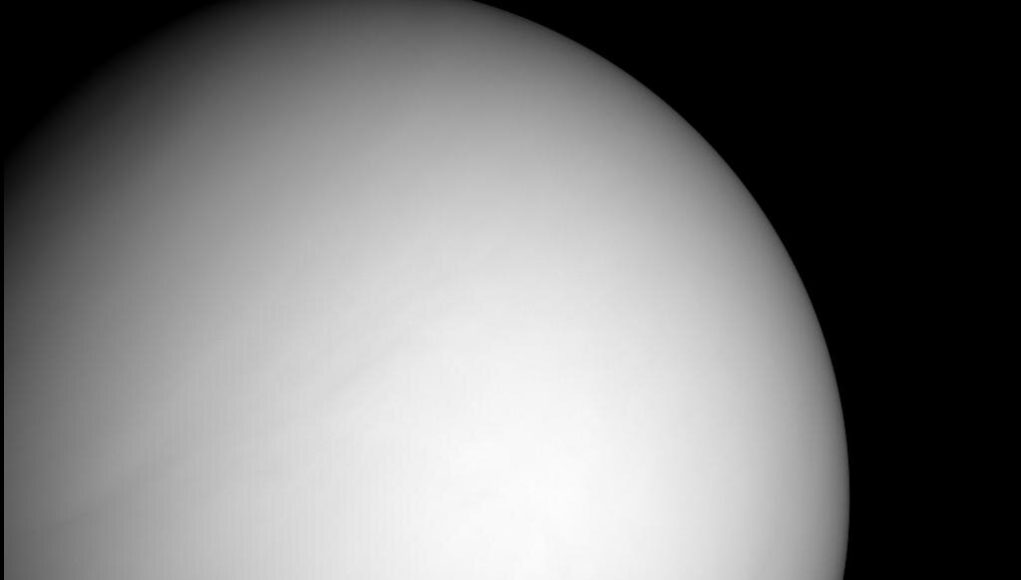Philosopher Nicholas Rescher once wrote, “Scientific discoveries are often made not on the basis of some well-contrived plan of investigation, but through some stroke of sheer luck.”
For a team of researchers at the Johns Hopkins Applied Physics Laboratory (APL) in Laurel, Maryland, that statement couldn’t be more true.
What started as a dry run to ensure instruments on NASA’s Mercury Surface, Space Environment, Geochemistry and Ranging (MESSENGER) spacecraft worked properly later turned into a 10-year saga that resulted in a chance discovery unrelated to the mission’s target planet, Mercury. It’s about Venus and its atmosphere.
The team reports April 20 in Nature Astronomy that data fortuitously collected by MESSENGER reveals a sudden rise in nitrogen concentrations at about 30 miles above Venus’ surface, demonstrating the planet’s atmosphere isn’t uniformly mixed, as expected. That finding upends an understanding about Venus’ atmosphere that has prevailed for decades.
The story started in June 2007 as MESSENGER sailed above Venus for its second flyby before veering toward Mercury. Mission instrument teams took the opportunity to test their devices and collect data before the real show was set to begin some six months later.
Find your dream job in the space industry. Check our Space Job Board »
Among the team members was David Lawrence, a nuclear physicist at APL. He was the instrument scientist for MESSENGER’s neutron spectrometer, which detects neutrons set loose into space from cosmic rays colliding with molecules in a planet’s atmosphere or surface. It aimed to find the telltale signs of neutrons coming from hydrogen atoms in water molecules that were suspected (and later confirmed) to be frozen in the crater shadows at Mercury’s poles.
Over Venus, however, Lawrence just wanted to collect some data to verify the instrument was operating correctly. An initial check showed it worked, and the data was tabled.
But in 2010, Lawrence revisited those measurements, this time with Patrick Peplowski, another nuclear physicist at APL. Despite 50 years of sending robotic missions to Venus, including 13 atmospheric probes or landers, a lot of uncertainty about the nitrogen concentration in Venus’ atmosphere, especially between 30 and 60 miles above the surface, remained.
That puzzled Peplowski and Lawrence because nitrogen is the second most abundant molecule floating in Venus’ atmosphere, after carbon dioxide.
“The uncertainty wasn’t necessarily just in the MESSENGER instrument—it could be in the entire planet,” Lawrence said.
Lawrence knew of a 1962 paper, however, that suggested neutron spectroscopy could help determine Venus’ atmospheric nitrogen concentration. Nitrogen is fairly good at scavenging loose neutrons, unlike carbon and oxygen, which are some of the worst. So on Venus, the number of neutrons an instrument detects should depend on the amount of atmospheric nitrogen.
MESSENGER just happened to collect that information.
The pair ran a computer simulation that divvied the planet’s 60-mile-thick atmosphere into bands in which they could manipulate the nitrogen concentration and realistically model how many neutrons would come streaming out to the spacecraft above.
When they compared their models with the MESSENGER data, they found the best match was when atmospheric nitrogen made up 5% of the volume, about 1.5 times that measured lower in the atmosphere. And all of the neutrons came from a region between roughly 35 and 60 miles above the surface—exactly where there had been the greatest uncertainty.
“That was very much a stroke of luck,” Peplowski said.
Why nitrogen increases at higher altitude remains unknown. Their discovery raised more than a few eyebrows, Peplowski said, but not because people were blown away.
“Many scientists seemed surprised that this was even something worth investigating,” Peplowski said. “The notion that there’s a higher nitrogen concentration in the upper atmosphere than in the lower was outside people’s range of thought.”
They ran into that impasse before when trying to get funding to complete the study. The project was denied money three times because it was considered a dead end. The data they needed to feel confident in their results and push their study over the finish line came by good fortune through Jack Wilson, an APL scientist who just happened to be analyzing the same MESSENGER data for an unrelated project.
After the team presented preliminary results during a conference in 2016, the Russian Federal Space Agency cited their work in its Venera-D mission to study Venus’ atmosphere and surface. Currently, two mission proposals under consideration for NASA’s Discovery Program—DAVINCI+ and VERITAS, both of which include APL scientists on their teams—also aim to study Venus’ atmosphere in greater detail.
Peplowski and Lawrence say this new result underscores the caution researchers need when drawing conclusions about atmospheric data, especially with the growing interest in planetary atmospheres in other solar systems.
“We’re still learning fundamental things about Venus and its atmosphere, and it’s our next-door neighbor,” Peplowski said. “That scientists can speak with confidence about the atmospheres of exoplanets that are hundreds or thousands of light-years away is worth questioning.”
Drawing rigorous and convincing conclusions requires a wide array of data.
But getting that data may sometimes require just a bit of good luck.
Provided by: Johns Hopkins University
More information: Patrick N. Peplowski et al. Chemically distinct regions of Venus’s atmosphere revealed by measured N2 concentrations. Nature Astronomy (2020). DOI: 10.1038/s41550-020-1079-2
Image: Venus as captured by NASA’s MESSENGER spacecraft on June 5, 2007. On the same day, MESSENGER’s neutron spectrometer collected data about neutrons emitting from Venus’ atmosphere, which scientists later realized could reveal details about nitrogen concentrations in the atmosphere.
Credit: NASA/Johns Hopkins APL/Carnegie Institution of Washington











